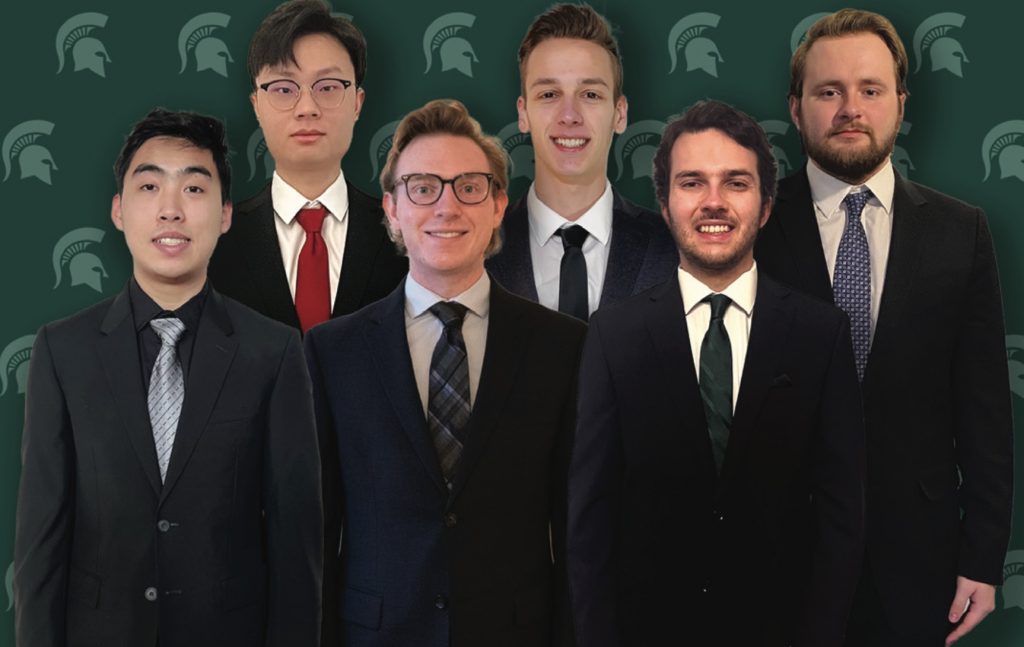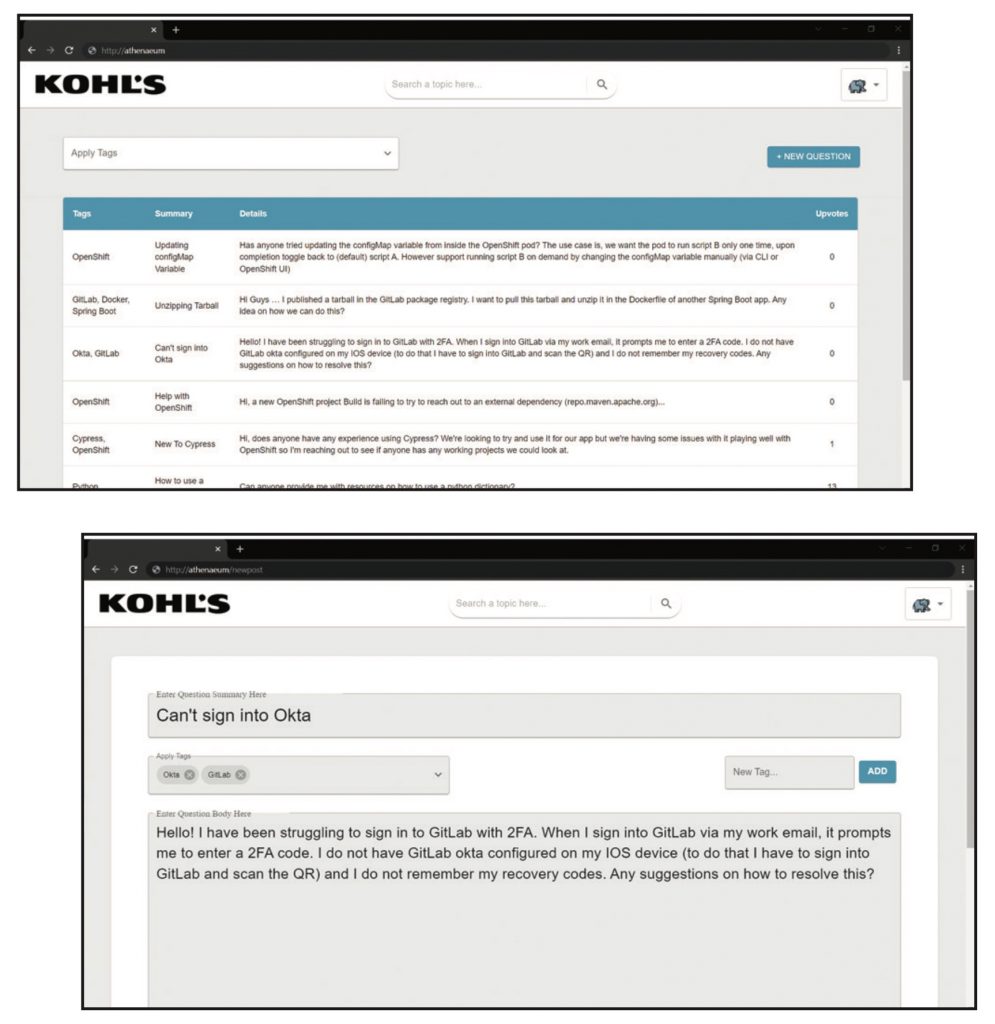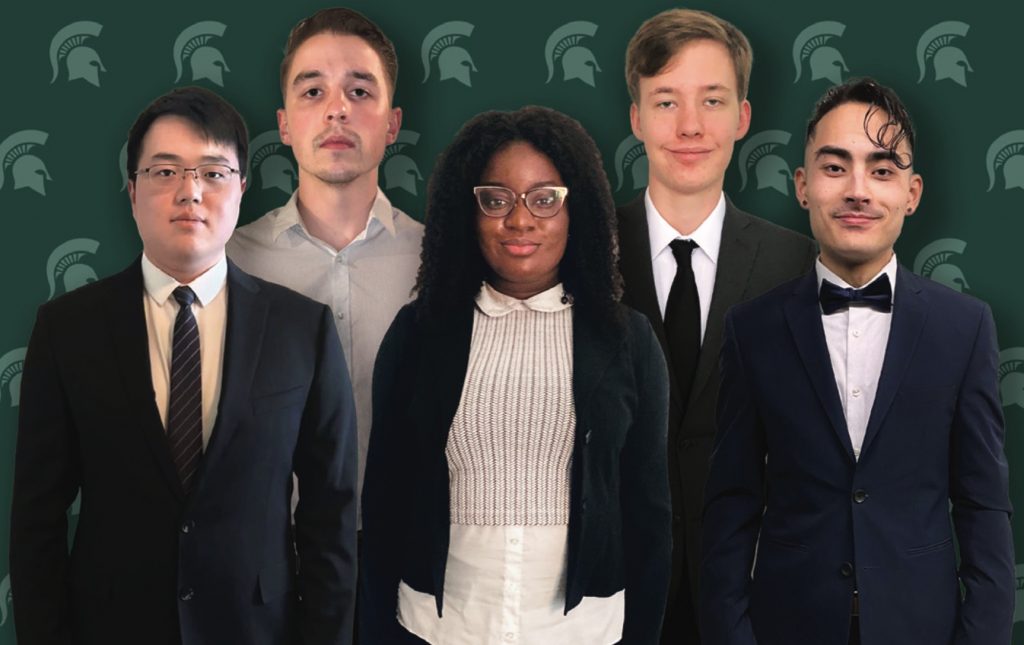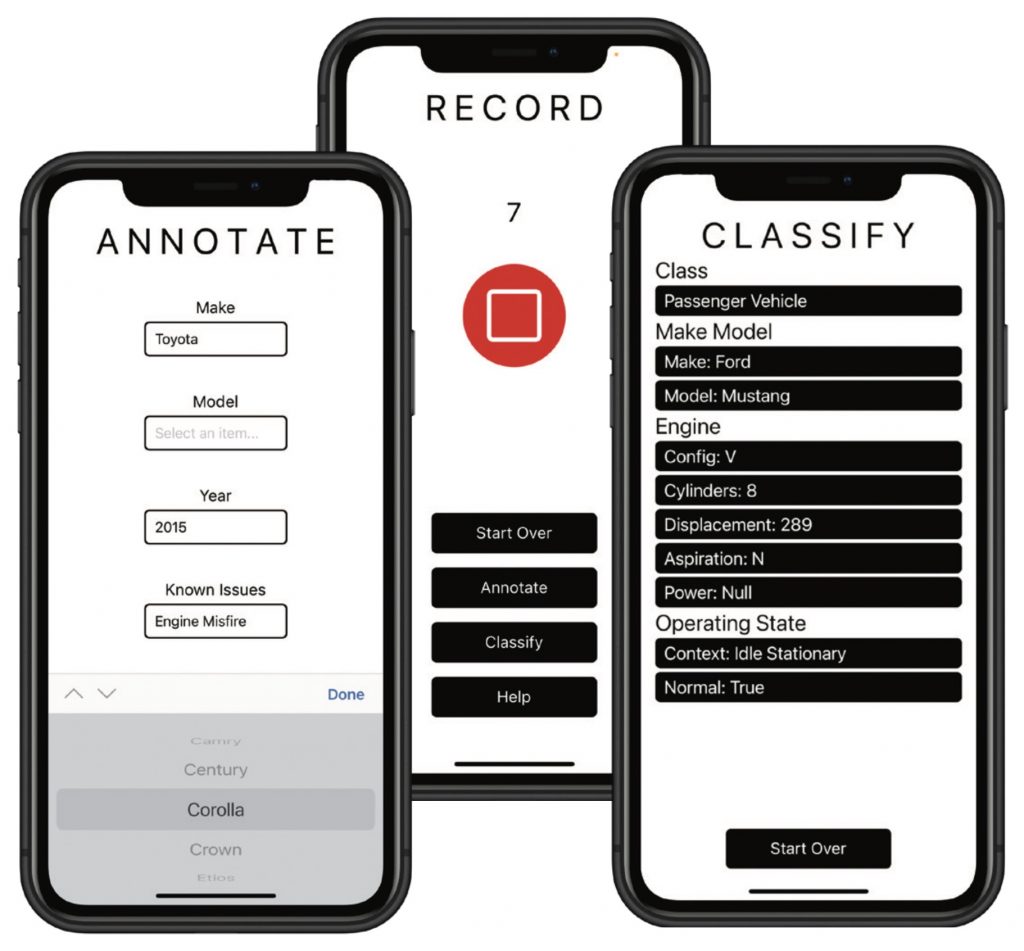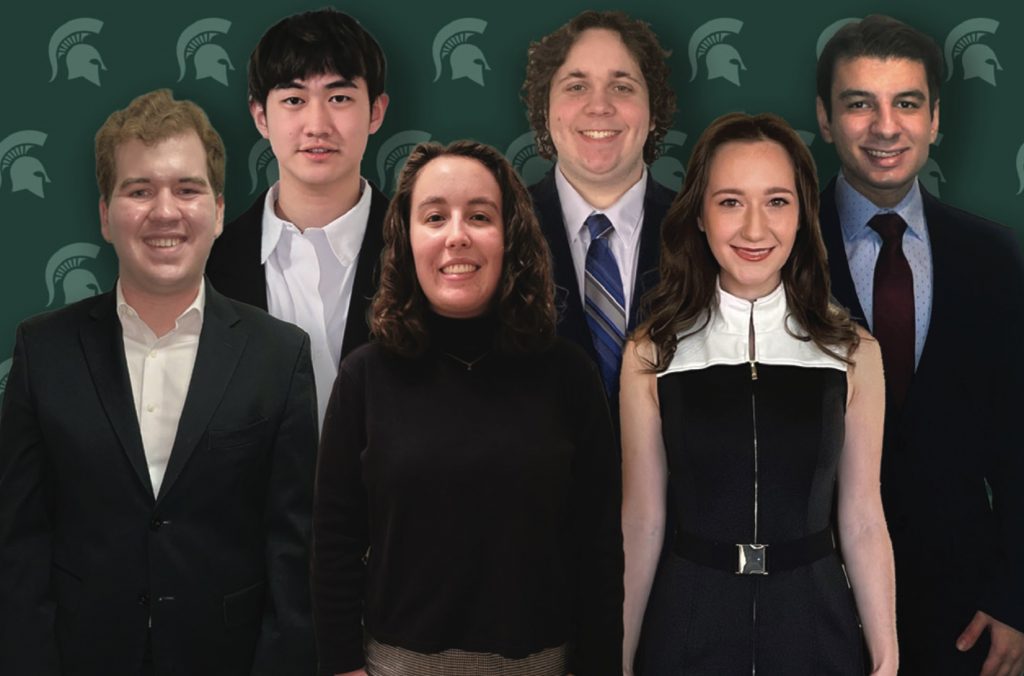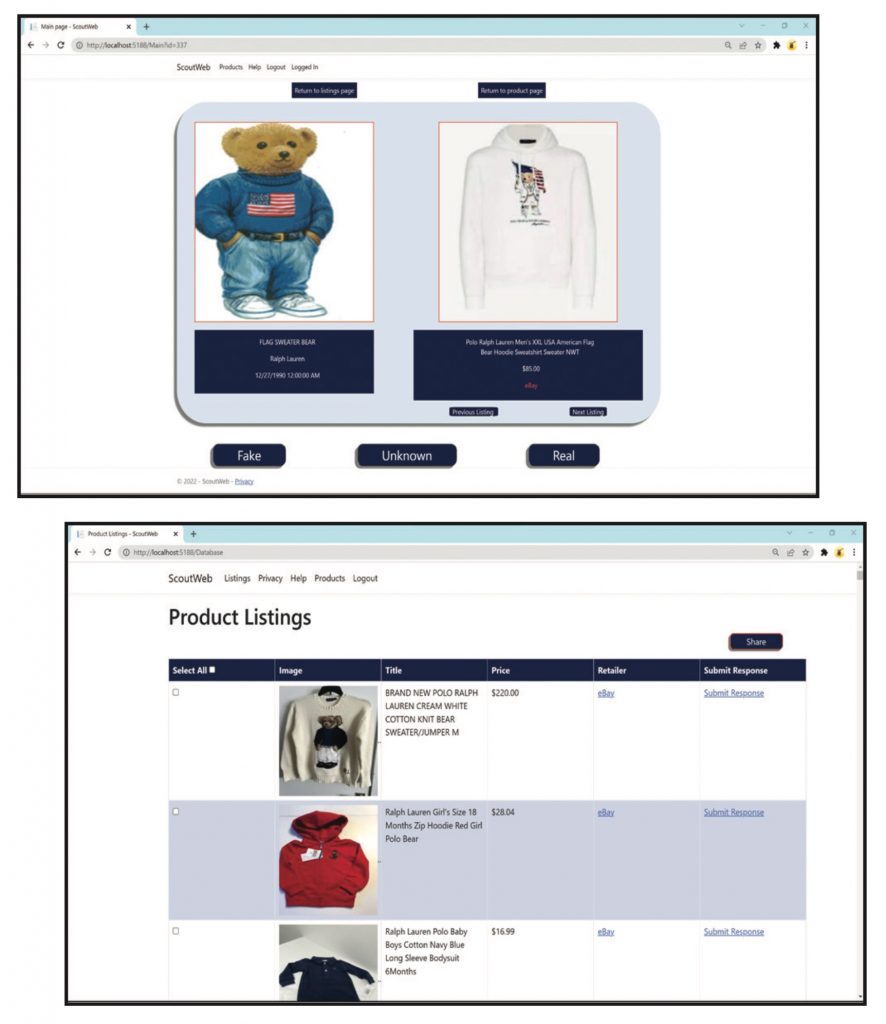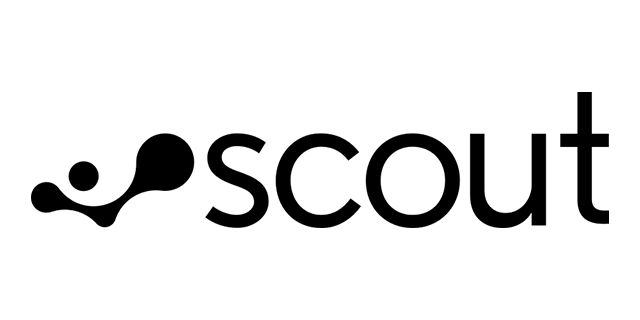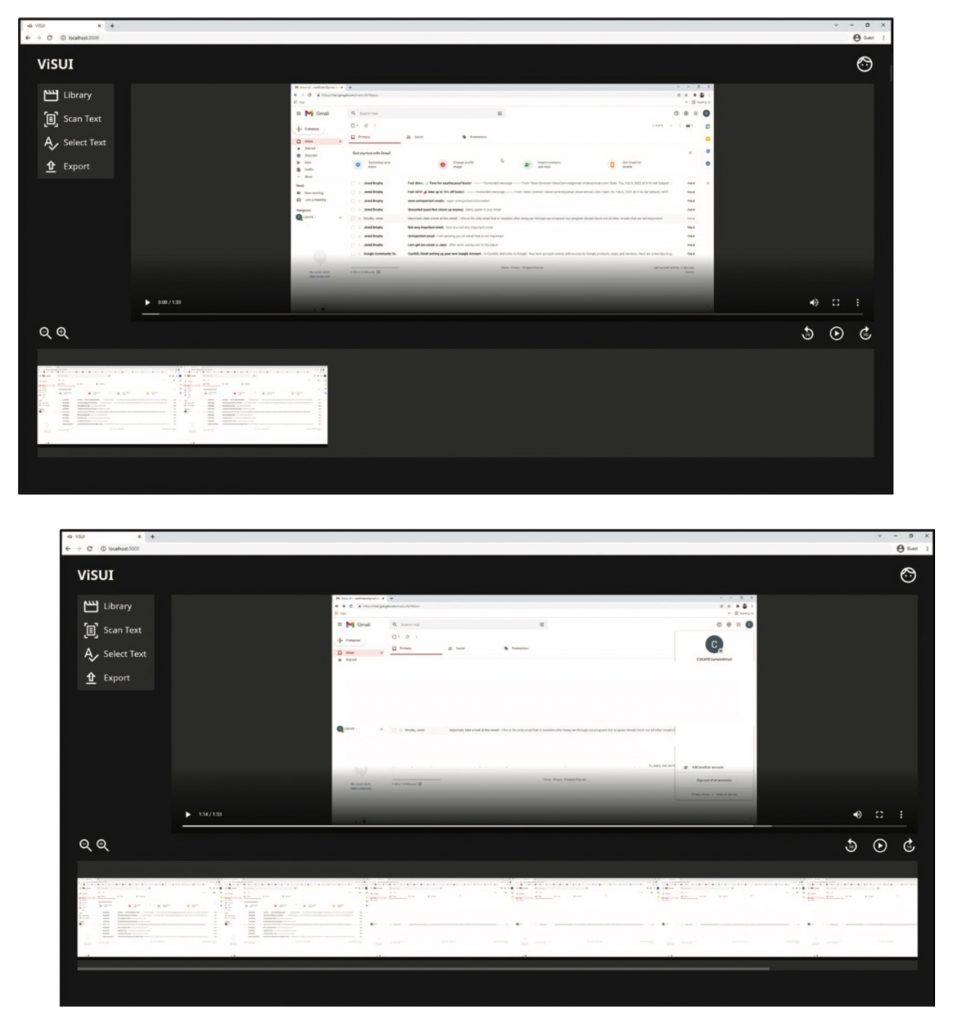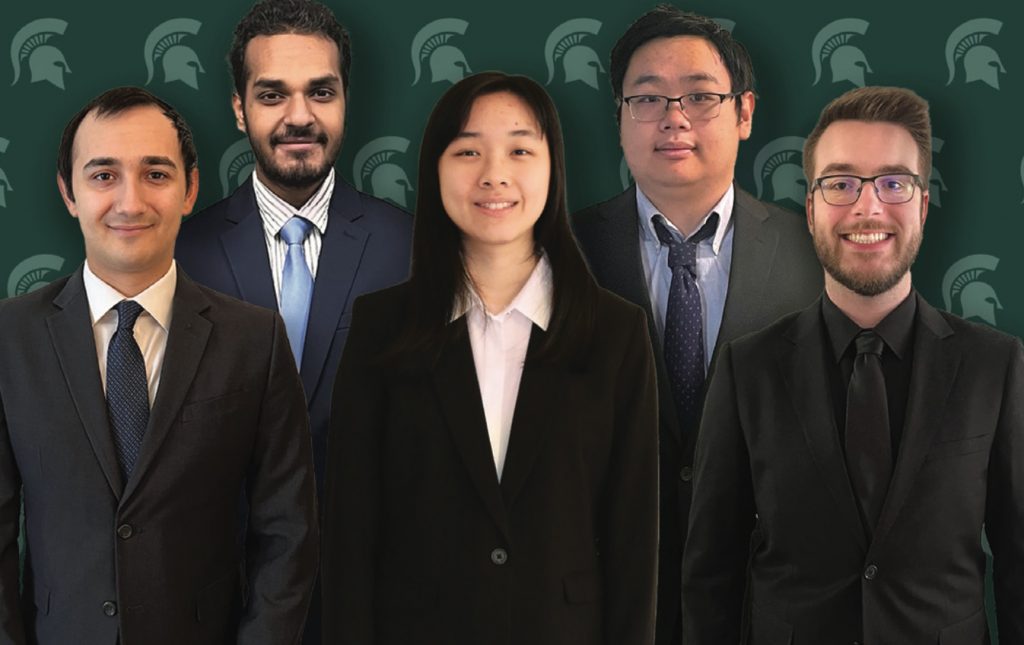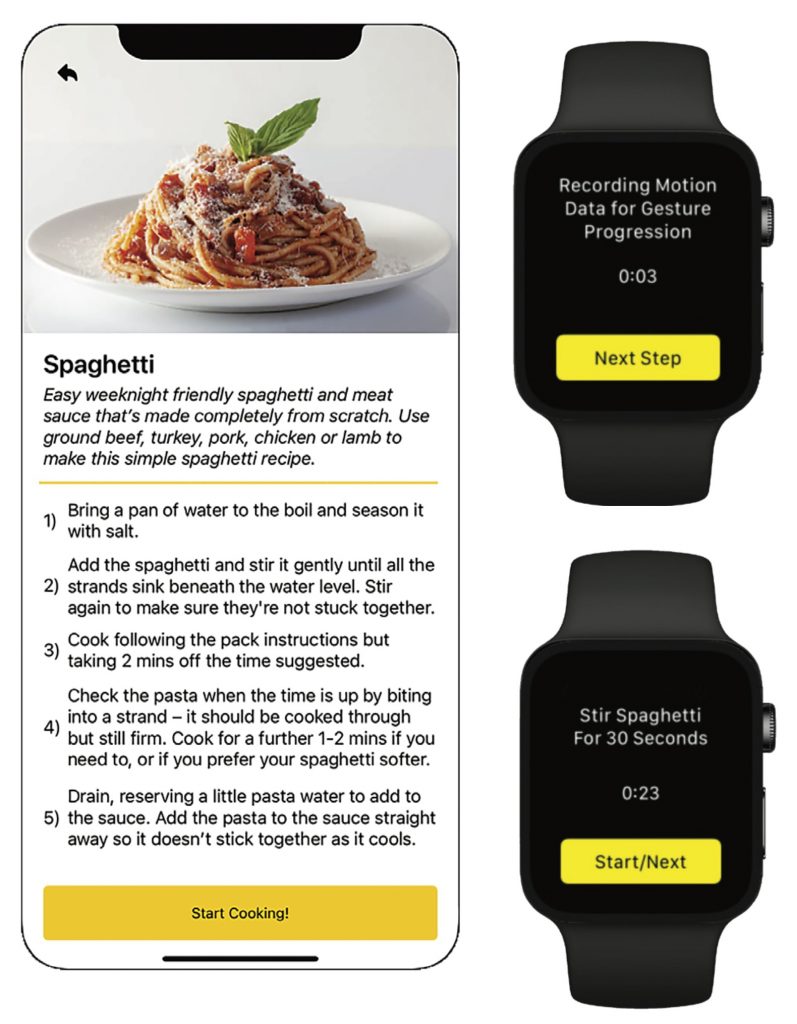Ally Financial: Ally P2P Lending Platform
Amazon: Amazon Shop Smart: Web Extension for Shopping
Anthropocene Institute: Wildfire Risks Forecasting Tool
Auto-Owners Insurance: RecruiTrack
Caxy Interactive: Remote Energy Distribution Payment Platform
CSAA Insurance Group: 3D Scene Reconstruction of Vehicle Accidents
Delta Dental of Michigan, Ohio and Indiana: General RAte Calculation Environment IDE
Delta Dental of Michigan, Ohio and Indiana: General RAte Calculation Environment Shell
Evolutio: ERP Reserve Preservation Platform
General Motors: High Frequency Data Ingestion
Kellogg’s: Global Business Services Customer Satisfaction
Kohl’s: Athenaeum
Lockheed Martin Space: SmartSatTM Satellite App Store
Malleable Minds: Advancing PreK-12 Educational Opportunities
MaxCogito: Blockchain Based Vaccine Passport System
Meijer: Meijer Smart Shopper
Michigan State University Computer Science: Data-Driven Mechanic: Applications and Infrastructure
Michigan State University Linguistics: On-Premises Automatic Speech Recognition Pipeline
Mozilla Corporation: Improve Firefox’s Reader View
MSU Federal Credit Union: Ever Green 3C: Financial Education Content Library
Rocket Companies: Team Member Mapping Application
Scout: Smart Little Hunter of Fakes
TechSmith: ViSUI: Video Simplified User Interface
Union Pacific: Railroad Data Visualization
United Airlines: Performance Scorecard Automation
United Airlines: Audit Management System
United Airlines: Training Forecast Model
Urban Science: Customer Insights Dashboard
Vectorform: Employee Recognition on Blockchain
Whirlpool Corporation: Recipe Progression Tracking
Ally Financial: Ally P2P Lending Platform
Ally Financial is a financial services company based in Detroit, Michigan, operating as one of the largest car finance companies in the United States. Ally offers online banking and online trading, bolstering the services they provide for their customers.
Acquiring loans is an important utility Ally provides its clients. However, sometimes customers desire to borrow a small sum of money and don’t want to go through a potentially lengthy process of submission and approval to do it.
Our P2P Lending Platform enables Ally clients to quickly loan each other money without the need for a bank to be a middleman.
Both lenders and borrowers can enroll in the platform. If a borrower is looking for a loan, they can simply post a loan request. Lenders can view this request and choose whether to accept it or not. Competitive interest rates are charged, and instant loan payout is supported.
The ability to combine loans ensures the best possible rate, granting even more flexibility. Lenders earn money by funding these loan requests from interest when clients repay their loans. Our software calculates risk scores for each loan to help lenders understand how likely the borrower is to be able to repay the money.
Our system facilitates quick and streamlined moneylending between users in a decentralized system, providing clients a quick way to acquire a loan.
Our front end is created using React and backed by Node.js, enabling us to manage and communicate among different software technologies.
Our back end is handled over the Ethereum blockchain to ensure quick and private ether transfers. This decentralized approach makes it possible for clients to use our P2P Lending Platform anywhere.
Michigan State University
Team Members (left to right)
Rocco Wu
Xiamen, Fujian, China
Johannes Shin
Farmington Hills, Michigan
Ray Sufyan
Dearborn, Michigan
Sonali Reddy
Walled Lake, Michigan
Mark Brandly
Big Rapids, Michigan
Nick Lim
Okemos, Michigan
Ally
Project Sponsors
Jared Allmond
Detroit, Michigan
Dan Lemont
Detroit, Michigan
Harish Naik
Detroit, Michigan
Susan Nord
Detroit, Michigan
Arvy Rajasekaran
Detroit, Michigan
Kevin Werner
Detroit, Michigan
Amazon: Amazon Shop Smart: Web Extension for Shopping
Headquartered in Seattle, Washington, Amazon is a Fortune 500 company that started out as an online bookstore but has grown to become one of the world’s largest online retailers and cloud services providers with Amazon Web Services (AWS). Amazon also provides various services such as audio and video streaming through their subsidiaries: Amazon Music and Prime Video.
Amazon works tirelessly to provide products to their customers that offer the best variety, price and convenience. As part of this endeavor, Amazon wants to ensure its customers are taking full advantage of Amazon’s prices and services when shopping on Amazon and other retail sites.
Our Amazon Shop Smart: Web Extension for Shopping is a browser extension that aids customers in finding the best deals on Amazon. Amazon Shop Smart tracks products indicated by customers, then periodically checks for price drops on Amazon’s marketplace. A notification is sent to the customer when their desired product is being sold at their ideal price point. Graphs of a product’s price history can be viewed to determine the optimal time to buy.
While browsing any supported E-commerce website, our Amazon Shop Smart extension provides customers with links to similar items that can be found on Amazon, as well as detailed information such as savings and shipping costs.
The front end of our Amazon Shop Smart: Web Extension for Shopping is built using HTML, CSS, and JavaScript, while the back end is implemented using AWS tools, including DynamoDB, Elastic Compute Cloud, Lambda, and Cognito. Our extension is available on Google Chrome and Microsoft Edge web browsers.
Michigan State University
Team Members (left to right)
Hithesh Yedlapati South Lyon, Michigan
Tianli Zhou
Wenzhou, Zhejiang, China
Emma Sickelsteel
Newaygo, Michigan
Jiashang Cao
Rochester Hills, Michigan
Richard Huang
Novi, Michigan
Jimmy Warner
Troy, Michigan
Amazon
Project Sponsors
Jeremy Fry
Detroit, Michigan
Garret Gaw
Detroit, Michigan
Erik Kamman
Detroit, Michigan
Tyler Rozwadowski
Detroit, Michigan
William Tanner
Detroit, Michigan
Anthropocene Institute: Wildfire Risks Forecasting Tool
The Anthropocene Institute is a non-profit organization located in Palo Alto, California. They unite entrepreneurs, thought leaders and investors to advance clean energy technology and climate policy.
The National Interagency Coordination Center reports that in 2020, 58,950 wildfires burned 10.1 million acres (about twice the area of New Jersey), the second-most acreage impacted in a year since 1960. Nearly 40% of these acres were in California. A vital component of wildfire safety is public awareness and education.
Our Wildfire Risks Forecasting Tool provides users with an interactive web application that helps them understand the impacts of wildfires in their communities. Our tool provides visualizations of wildfire spread, as well as educational information about damages posed by wildfires and strategies for wildfire mitigation.
Our tool utilizes decades of research conducted by the US Forest Service to create an accessible, physics-based wildfire simulation interface that shows how a wildfire might spread.
Individuals can simulate fires under a wide variety of conditions, including current or historic weather conditions, and can also manually adjust parameters such as temperature, humidity, wind speed, and wind direction. In addition to wildfire spread, users can view estimates of damage caused by these fires as well as footprints of historic fires. Our tool provides users with strategies to enhance their own safety and the safety of their communities.
The simulation model is based on FARSITE, utilizing weather and fuel data curated by US Government agencies. The tool is fully implemented in Python. Our back end uses the robust geospatial data frameworks of Xarray and netCDF, as well as the numerical efficiency of NumPy and Numba. Our front end is a Flask-based web server utilizing Plotly for visualization.
Michigan State University
Team Members (left to right)
Andrew McDonald
Hudson, Ohio
Jamie Schmidt
Cleveland, Ohio
Ben Miller
Canton, Michigan
Jingxian Chen
Beijing, Beijing, China
Nathan Woods
Evart, Michigan
Andrew Haas
Lansing, Michigan
Anthropocene Institute
Project Sponsors
Richard Chan
Palo Alto, California
Frank Ling
Tokyo, Japan
Carl Page
Palo Alto, California
Auto-Owners Insurance: RecruiTrack
Auto-Owners Insurance is one of the largest insurance companies in the United States. Operating in 26 different states, along with the corporate office based in Lansing, Michigan, Auto-Owners services almost 3 million policyholders.
With such a large company, there is a plethora of employees throughout the states of operation. Every one of these employees must perform to the standards of the company, and the recruiting team plays a significant role in this. This team works diligently to find the best people for the numerous positions that exist at Auto- Owners. With so much potential talent, there is a great deal of work involved in finding the best candidates.
Our RecruiTrack system is a web application that alleviates the amount of labor that recruiters must use to keep track of all the different places from where they recruit talent, as well as tracks the information that must be noted to make sure all the recruiting events they attend are properly staffed and fully funded.
As RecruiTrack is populated with the data that recruiters at Auto-Owners must keep track of, this application becomes a one- stop shop for all things recruiting. It can be accessed through any device that has a web browser.
The app automates reports that must be generated by recruiters to get funding approved for all the events that they organize each year, provides accessible, easy-to-read tables with all the essential recruiting data they currently have, and enables users to manually input and edit data in the application.
With RecruiTrack, recruiters spend less time on manual data entry and writing reports, instead spending more time out in the field finding the best, new talent through this intuitive website.
RecruiTrack is hosted on a Windows server with our front-end software built with Angular, our back-end software built with Java, and a Microsoft Azure SQL Server Database for database hosting.
Michigan State University
Team Members (left to right)
Michael Liu
Qingdao, Shandong, China
Sophie Martin
Dearborn, Michigan
Andrew Nader
Lansing, Michigan
Ken Michalak
Novi, Michigan
Jacob Riggs
Allen Park, Michigan
Auto-Owners Insurance
Project Sponsors
Matthew Alashari
Lansing, Michigan
Tony Dean
Lansing, Michigan
Ross Hacker
Lansing, Michigan
Scott Lake
Lansing, Michigan
Caxy Interactive: Remote Energy Distribution Payment Platform
Caxy Interactive is a full-stack digital development company based in Chicago, Illinois. For over 20 years, they have offered solutions for a variety of sectors, including non-profits, startups, and educational programs.
Reliable energy access is not only essential but also fundamental, for developing regions. Caxy Interactive’s focus is to provide accessible energy for central African regions where energy is needed, such as in Cameroon, where less than 27%, or 8 million rural Cameroonians, have minimal access to energy.
Our Remote Energy Distribution Payment Platform (REDPP) offers a lightweight solution for hardware charging stations to support off-grid charging by providing the ability to access, track, and manage energy transactions with SMS and an online interface.
REDPP provides a customer with the capability to credit an account by text. Preloaded with a balance, customers send text messages to the server to withdraw funds for charging electronic devices.
The web application provides different insights depending on the type of the user account. Customers can view their transaction history and add funds. System administrators can set rates, view information about customers, and manage charging stations.
Our application aids in the mission of providing rural regions access to energy sources to support the development of those areas.
Express supports the back end, while the front end uses Pug, an HTML pre-processor. Web app sessions use Firebase Authentication to manage users’ web interactions. Non-sensitive account information and transactions use MongoDB. Stripe is used to process fund additions to accounts by using secure API calls. The cloud application platform, Heroku, provides the server to host the web application. SMS is connected to the server through the Twilio API.
Michigan State University
Team Members (left to right)
Jakob Therkelsen
Lambertville, Michigan
Jesse Stroster
West Bloomfield, Michigan
Olivia Qiu
Livonia, Michigan
Akshaan Garg
Panchkula, Haryana, India
Connor Mears
Linden, Michigan
Avery Lyu
Zhaotong, Yunnan, China
Caxy Interactive
Project Sponsors
David Giordano
Chicago, Illinois
Michael LaVista
Chicago, Illinois
CSAA Insurance Group: 3D Scene Reconstruction of Vehicle Accidents
CSAA Insurance Innovation, a subsidiary of AAA Insurance operating out of Walnut Creek, California, is a top-tier insurance group dedicated to aiding clients in the prevention, preparation, and recovery from life’s uncertainties, challenging itself to serve with the utmost care. Advocating for vehicle and road safety since 1907, they now offer home, auto, and other lines of insurance across 23 states.
To support members, CSAA analysts must accurately investigate auto claims. Improper analysis slows member recovery and planning by presenting a poor understanding of vehicular damage.
Our 3D Scene Reconstruction of Vehicle Accidents provides thorough annotation and damage analysis capabilities within an interactive 3D environment. This augments CSAA’s current system by increasing the speed, detail, and precision with which analysts produce cost estimations.
Using a virtual reality headset or desktop application, analysts can rotate and pan within the generated scene to better examine vehicle conditions, while comparing the original and claimant vehicles as the tool highlights damages. Analysts can create and place annotations on the vehicle to include information regarding the location, severity, cost, and description of damages. Alongside annotations, analysts have access to vehicle and claimant information, a menu for conclusions, the ability to export results, and multiple options regarding screen preferences. Our application improves the ability of analysists to accurately assess vehicular damage for precise analysis of claimants’ vehicles.
The Unity-built user interface leverages a Python back end. It uses API endpoints to verify claimant data against CSAA’s databases, highlights vehicle damages, and reconstructs a 3D model from claimant vehicle videos through NeRF Modeling, producing an interactive OBJ file for analysts.
Michigan State University
Team Members (left to right)
Kaan Salt
Istanbul, Turkey
Wendy Wu
Jinan, Shandong, China
Varsha Narmat
Grand Ledge, Michigan
Angelo Savich
White Lake, Michigan
Owen D’Aprile
Northville, Michigan
Elizabeth Lipin
West Bloomfield, Michigan
Caxy Interactive
Project Sponsors
Beti Cung
Walnut Creek, California
Anthony Duer
Walnut Creek, California
Emeri Zhang
Walnut Creek, California
Delta Dental of Michigan, Ohio and Indiana: General RAte Calculation Environment IDE
Delta Dental is the leading provider of dental insurance in the United States. They operate in all 50 states and provide high- quality and cost-effective coverage for nearly one in four Americans.
Professional underwriters and actuaries collect and analyze data to quantify risk for insurance policies in a process called “rate calculation.” In the past, Delta Dental employees performed these calculations manually, which was time-consuming.
Delta Dental’s solution to modernizing this system is the General RAte Calculation Environment (GRACE). GRACE uses a specialized programming language where users can easily process insurance data.
Our GRACE integrated development environment (IDE) assists Delta Dental developers in effectively writing code for the GRACE system by making it easier to develop programs.
Our software colors important areas of code and underlines errors while typing. Additionally, GRACE IDE suggests variable names and common code structures to save time writing code.
An outline of variables appears alongside the code editor as a quick reference for what kind of information the variable holds. Users can also select one of these variables to instantly go to where the variable first appears in the file.
Our software uses a workspace system for users to quickly navigate between related code files while working on projects. As users open a folder in our software, the files and subfolders add to the workspace. New files created in the software are saved to the workspace at a user’s option.
Our system provides the tools needed in order to expedite GRACE program development, increasing productivity.
Our GRACE IDE is a client-side browser application built with Angular for its user interface, Antlr4 for language processing, and the Monaco Editor for the code editor component.
Michigan State University
Team Members (left to right)
Justin Swinehart
White Lake, Michigan
Hyunmin Kim
Rochester Hills, Michigan
Anthony Rodeman
Grand Ledge, Michigan
Joey Nagy
Northville, Michigan
Qinghao Shen
Shanghai, Shanghai, China
Delta Dental Knowledge Science 1
Project Sponsors
Mukundan Agaram
Okemos, Michigan
Will Cicola
Okemos, Michigan
Jacob Ernst
Okemos, Michigan
Toby Hall
Okemos, Michigan
Chang (Charlie) Liu
Okemos, Michigan
Delta Dental of Michigan, Ohio and Indiana: General RAte Calculation Environment Shell
Covering more than 78 million Americans, Delta Dental operates one of the largest dental plan administrators in the United States. Over the past 70 years, Delta Dental has created innovative, data-driven technology that increases quality of care while decreasing customer costs.
As an insurance company, Delta Dental continuously compiles and analyzes insurance data to build better plans that decrease costs to their customers and partners. This is achieved through the General RAte Calculation Environment (GRACE), which enables insurance data to be processed efficiently.
Our GRACE Shell enables users to streamline their development inside of Delta Dental’s vast ecosystem of tools with an emphasis on utility and accessibility.
Our command line interface offers a powerful but simple tool to enable fast prototyping, testing, and debugging across the complex rate calculation domain. Programs can be run, tested, and debugged quickly through intuitive commands. Furthermore, the simplicity of our software enables non-technical users, such as actuaries or underwriters, to easily navigate and build models.
The GRACE shell creates an environment where users can dynamically build their prototypes. As the user develops, they can easily create, undo, load, save and share their work in a responsive and robust environment.
Our system facilitates simple building and testing of GRACE programs, enabling non-technical users to develop software quickly without prior training, saving time and cutting costs.
The front end of our software is built in Java, utilizing the Picocli command line interface framework and Maven project management software. The back end uses Delta Dental’s existing core libraries containing fundamental calculation algorithms and data structures.
Michigan State University
Team Members (left to right)
Huy Nguyen
Hanoi, Hanoi, Vietnam
Yang Zhao
Chengdu, Sichuan, China
Justin Park
Bloomfield Hills, Michigan
Dylan Boyd
Saline, Michigan
David Robbins
St. Johns, Michigan
Kyle Ernster
Novi, Michigan
Delta Dental Knowledge Science 2
Project Sponsors
Mukundan Agaram
Okemos, Michigan
Daniel Durusoy
Okemos, Michigan
Toby Hall
Okemos, Michigan
Chang (Charlie) Liu
Okemos, Michigan
Evolutio: ERP Reserve Preservation Platform
Evolutio is a group of technology professionals convinced that business problems have simpler solutions than the market is led to believe. Evolutio works with the non-profit, Elephants, Rhinos and People (ERP), to preserve and protect wild elephants and rhinos in Southern Africa through a distinctive strategy based on rural poverty alleviation. The desired result is that community members have access to income through non-lethal alternatives to poaching.
ERP is constantly taking steps forward to ensure that the poaching problem is being mitigated in the short term, while working towards alleviating poverty in the long term. These steps include elephant relocation, veterinary emergency response units, drought relief programs, threat detection, drone air force, and an extensive reserve ranger program.
Our ERP Reserve Preservation Platform is an intuitive web and mobile application makes the lives of those working on the reserve easier by aiding in the success of these short-term goals.
The platform includes a community member and ranger work scheduling system with notifications built in, a system to view live- stream footage of the reserve for security purposes, a place to view footage from the drone air force, and GPS tracking of elephant migration. The platform contains a quizzing system to evaluate the skills and knowledge of those seeking to be a community member or ranger as well.
The community members and rangers benefit from a single platform to view all reserve security tools and management systems in one single place. This platform makes the quality of life better and daily tasks go smoother for those on the reserve, while dealing with very busy, yet engaging, lives.
The ERP platform is developed with the React Native and Flask framework, alongside Python and JavaScript, and deployed onto Heroku.
Michigan State University
Team Members (left to right)
Jinxuan Zhang
Wenling, Zhe Jiang, China
Stefan Najor
West Bloomfield, Michigan
Riley Thompson
Walled Lake, Michigan
Matt Delanoy
Shelby Township, Michigan
Jake Lankfer
New Era, Michigan
Braedyn Lettinga
Grand Rapids, Michigan
Evolutio
Project Sponsors
Jordan Cobe
Lansing, Michigan
Bob Dyksen
St. Louis, Missouri
Devin Stonecypher
Fremont, California
Adam Ties
Indianapolis, Indiana
Laura Vetter
Chicago, Illinois
General Motors: High Frequency Data Ingestion
General Motors, headquartered in Detroit, Michigan, is the largest vehicle manufacturer based in the United States. OnStar, a subsidiary of General Motors, provides in-vehicle communications, security, navigation, and remote diagnostics.
Within a week of COVID-19 being declared a national emergency, General Motors and OnStar shifted approximately 12,000 OnStar service agents from extremely predictable call center environments to largely variable home offices.
OnStar agents conduct phone calls to vehicles via an internet connection requiring fast and reliable speeds for phone calls to be clear. General Motors IT must know when internet speeds drop, as poor call quality can result in customer dissatisfaction.
Currently, connection speed records are automatically gathered on OnStar agents’ computers into files, which are then regularly transferred to a centralized server for processing. When thousands of OnStar agents are online and making calls, the server processing often becomes backlogged, and data is sometimes lost.
Our High Frequency Data Ingestion application resolves the bottlenecks induced by influxes of data by providing efficient file reading, processing, and writing operations. Furthermore, existing backlogs of files are resolved by limiting the number of data points for any given OnStar agent.
In addition to data ingestion, our software features interactive web dashboards. Data from the ingestion application can be analyzed on multiple webpages. This data includes the OnStar network metrics, OnStar agent comparison tables, and ingestion application processing statistics.
The ingestion application is written in C# and is optimized to work with Microsoft network-attached storage drives and a Microsoft SQL Server. The web application is written in Python Flask and uses Socket-IO and Plotly for plotting.
Michigan State University
Team Members (left to right)
Kevin Zhong
Troy, Michigan
Felix Zhang
Foshan, Guangdong, China
Dave Yonkers
Lake Orion, Michigan
Kory Gabrielson
Rochester, Michigan
Dave Karlavage
South Lyon, Michigan
Joseph Kasza
Saline, Michigan
GM
Project Sponsors
Taylor Bolton
Chandler, Arizona
Brian Chubick
Austin, Texas
James Currie
Detroit, Michigan
Fred Killeen
Detroit, Michigan
Todd MacKenzie
Austin, Texas
Spencer Searle
Detroit, Michigan
Kellogg’s: Global Business Services Customer Satisfaction
Kellogg’s, headquartered in Battle Creek, Michigan, is the world’s leading producer of cereal and a leading producer of snack and convenience foods with commonly known brands like Pringles, Cheez-Its, and Frosted Flakes.
With products manufactured in 18 countries and marketed in over 180 countries worldwide, Kellogg’s works to provide quality products and services to all its customers and clients. To this end, Kellogg’s Global Business Services (GBS) team distributes a quarterly customer satisfaction survey to stakeholders.
The GBS survey contains a series of standardized questions related to the quality and ease of the stakeholders’ use of GBS services as well as open-ended questions where stakeholders can provide suggestions and feedback for improvement. In the past, the survey has not reached the target response rate, which makes it harder for Kellogg’s to provide the customer service that meets their high standards.
Our Global Business Services Customer Satisfaction system includes a redesign of the user interface of the survey and a web dashboard used to visualize analytics.
Our new Global Business Services customer satisfaction survey has built-in user behavior collection, automated data visualization, automatic survey translation and easier survey question updating mechanisms.
The analytics provided by our web dashboard regarding user behavior and responses has led to an increase in the response rate of the survey from 7% to 15%. This increase in response rate enables Kellogg’s to develop a more detailed and strategic plan to provide customers with better products and a more fulfilling experience.
Users access the survey on a web application built in R with R-Shiny for the user interface. The data is stored in Amazon S3, and the data visualization is done through Tableau.
Michigan State University
Team Members (left to right)
Henry Xu
Novi, Michigan
Dhiloj Vigneswaran
Hatton, Central Province, Sri Lanka
Sarah Funk
Troy, Michigan
Kathy Gu
Canton, Michigan
Ben Person
Rochester Hills, Michigan
Kellogg’s
Project Sponsors
Deanna Adler
Battle Creek, Michigan
Travis Beuchler
Battle Creek, Michigan
Federico Conde
Battle Creek, Michigan
Katrina Gensterblum
Battle Creek, Michigan
Diana Morehouse
Battle Creek, Michigan
Debra Nave
Battle Creek, Michigan
Lesley Salmon
Battle Creek, Michigan
Kohl’s: Athenaeum
Headquartered in Menomonee Falls, Wisconsin, Kohl’s operates as one of the largest department store chains in the world. The company’s business line features apparel, footwear, accessories, beauty and home products through its stores and website.
At Kohl’s, technology teams are constantly exploring, designing, and developing new ways to make the customer’s shopping experience more effortless and unique to them. In order to accomplish this, developers need to be able to share their questions and technical issues with each other.
Previously, the Kohl’s development teams shared a massive group chat of over 500 developers, where their questions were not only difficult to track, but were also redundant, creating a very disorganized and confusing forum.
Our Athenaeum web application provides an effective solution to this disorder by acting as a centralized platform for the Kohl’s development teams to better coordinate collaboration.
Athenaeum is an organized platform that brings order and clarity to the Kohl’s development teams; with Athenaeum, Kohl’s developers can find solutions to their technical issues with ease. Athenaeum’s web interface provides an easy place for developers to ask questions, receive feedback from other developers, search for related questions, and collaborate with their colleagues.
The platform’s simple and intuitive user interface gives developers the visual clarity for their collaboration, so that they can easily navigate their way to a solution for each technical issue that arises. Moreover, Athenaeum makes collaboration fun, utilizing a point system to gamify the experience of sharing solutions and resolving each other’s issues.
With a ReactJS front end, Flask back end and MySQL database, Athenaeum is deployed on Google Cloud Platform, making the web app fully cloud native.
Michigan State University
Team Members (left to right)
Lucas Barron
Troy, Michigan
Tim Kowalski
Pinckney, Michigan
Jason Israilov
West Bloomfield, Michigan
Ryan Felten
Wyoming, Michigan
Jacob Mackay
Macomb, Michigan
Bryan Vi
St. Joseph, Michigan
Kohl’s
Project Sponsors
Christian Madrigal
Menomonee Falls, Wisconsin
Sean Malloy
Menomonee Falls, Wisconsin
Vinny Sabatini
Menomonee Falls, Wisconsin
Will Simmons
Menomonee Falls, Wisconsin
Ramesh Venkitaswaran
Menomonee Falls, Wisconsin
Will White
Menomonee Falls, Wisconsin
Lockheed Martin Space: SmartSatTM Satellite App Store
Lockheed Martin Space, headquartered in Denver, Colorado, is one of the largest space defense contractors in the world, employing over sixteen thousand people, with the goal of developing an impressive range of products from satellites and space probes to missile defense systems.
Storage space, processor utilization, and memory utilization are important factors to consider when deploying software to satellite assets. Applications may also require additional dependencies that must be present on an asset before an application can run.
Our SmartSat Satellite App Store is a web-based marketplace for uploading and installing applications to live satellites with rigorous software testing capabilities to guarantee the software runs successfully on these satellites.
During the testing process, the app store monitors the system resource utilization of the application. When an application is uploaded or deployed, the system ensures the correct dependencies are installed on an asset.
During the testing process, an application manager monitors the resource utilization of the target application. These metrics are sent back to the app store and displayed for operators to view.
The app store automatically keeps a record of an application’s dependencies to ensure the required packages necessary for an application to run are installed on the asset. Our SmartSat App Store provides satellite software with assurances that the software is reliable and functional when uploaded to a satellite.
The app store uses a Jenkins pipeline for testing. Data is stored in a Nexus repository, as well as a PostgreSQL database, which is managed by pgAdmin. The web back end is built with Flask, while the front end is built with React. All components of the SmartSat Satellite App Store are built in Docker containers to ensure system portability.
Michigan State University
Team Members (left to right)
Mike Kilmurray
Wixom, Michigan
Matt Harper
South Lyon, Michigan
Sirena Ly
Holland, Michigan
Kaleb Koebel
Stevensville, Michigan
Quinn Farrar
Rochester, Michigan
Cody Lowen
Waterford, Michigan
Bryan Vi
St. Joseph, Michigan
Lockheed Martin Space
Project Sponsors
Josh Davidson
Littleton, Colorado
Brandon Hearn
Littleton, Colorado
Bill Holway
Littleton, Colorado
Tony Miller
Littleton, Colorado
Krystyn Ream
Littleton, Colorado
Malleable Minds: Advancing PreK-12 Educational Opportunities
Malleable Minds is an emerging startup building the world’s most extensive collection of PreK-12 programs, from the arts to the sciences, so students can further develop academic, interpersonal, and communication skills. The Malleable Minds web app connects students to programs that interest them and contributes to their academic success.
However, it can be difficult for users to navigate the vast collection of programs and plan their customized education path. Displaying such a large collection of information can also lead to slowed site loading speeds.
Our Web App for Advancing PreK-12 Educational Opportunities helps users find the programs best suited for them, track their progress in-site, and improves website performance.
Better navigational features include website subject pages, such as art or science, enabling users to see all of the programs offered in categories of interest. Clicking on a program redirects users to the program page, which holds information such as the provider, location, and cost. This page also includes the program’s ratings and reviews left by users after experiencing the program.
The skill tree feature enables users to plot out how to achieve their future goals. Users can track their progress and explore future opportunities in a given subject area. Any progress made on skill development is tracked and the next steps for skill growth are clearly displayed.
Our system improves the existing application by better guiding users to find the programs that are right for them, increasing engagement and customer satisfaction.
The front end is written in React JS, and the back end is in Python. Our site also makes extensive use of Amazon Web Services. By using AWS Lambdas, the back end is serverless to improve site- wide performance.
Michigan State University
Team Members (left to right)
Siyuan Rong
Ningbo, Zhejiang, China
Alex Ralya
Grand Ledge, Michigan
Temi Agbebi
Canton, Michigan
Travis Walton
Ann Arbor, Michigan
Noah D’Arcy
Novi, Michigan
Malleable Minds
Project Sponsors
Ripple Goyal
Los Angeles, California
Cathalina Juarez
Frederick, Maryland
James Pita
Frederick, Maryland
MaxCogito: Blockchain Based Vaccine Passport System
MaxCogito, founded by Steve Akers, is a young company that provides high value cloud services to their clients. They focus on providing their clients with strategies for protecting and appropriately managing sensitive documents and communications.
With the onset of the COVID-19 pandemic, humanity has faced new challenges, and different types of vaccinations have been provided as a response to the virus. However, the paper-based immunization status cards currently provided by clinics and hospitals can be stolen, lost, or falsified.
Our Blockchain Based Vaccine Passport System provides reliable and secure vaccination status of users, which cannot be falsified and are secured on the internet.
Our system is accessed by patients and vaccine administrators through an easy-to-use web interface. After receiving a vaccine, users upload a copy of their vaccine record as well as some supplementary data. Vaccine clinics and hospitals then use our web application to validate any vaccine records uploaded by their patients. Once a patient’s vaccine record is verified as authentic, the patient can request a vaccine passport from our system that can be used to verify their vaccination status whenever needed.
The vaccine verification is built on Blockchain technology that provides a safe and secure way to apply for vaccination status, which cannot be changed or deleted following verification by the client’s health care provider.
Our system provides ease of use for individuals wanting absolute proof of their vaccination status and peace of mind for anyone needing to verify vaccination status beyond any doubt.
The front end of our system is developed using HTML, CSS, Angular and TypeScript. Our back end uses Spring Boot, Web3j, and a PostgreSQL database hosted on AWS. Our Blockchain is built on Ethereum, utilizing Solidity for our Smart Contracts.
Michigan State University
Team Members (left to right)
Moez Abbes
Bardo, Tunis, Tunisia
Drew Decrem
Irvington, New York
Daniel Adu-Djan
Nkoranza, Bono East, Ghana
Alex Holt
Rochester Hills, Michigan
Samgar Kali
Almaty, Almaty, Kazakhstan
Lucas Sariol
Chesterfield, Michigan
Malleable Minds
Project Sponsors
Steve Akers
Mashpee, Massachusetts
Meijer: Meijer Smart Shopper
Meijer is a family-owned business founded in 1934 that has pioneered the one-stop shopping experience. With over 240 shopping centers operating in the Midwest, Meijer provides a wide array of products from household items to pharmaceuticals.
Grocery shopping is a task that takes organization and planning. Adding an item to a shopping list requires resources like time, memory and a list itself. Often, shoppers think of an item they need but don’t have those resources readily available. Moreover, shoppers can be unsure of what Meijer coupons, called mPerks, apply to the items on their list, or if that item is available at their local Meijer.
Our Meijer Smart Shopper enables customers to use Alexa to interact with the Meijer application, simplifying the shopping experience. A shopper can interact with our application using their phone’s microphone or an Alexa-enabled device.
In a verbal interaction with Alexa, a shopper can add or remove items from their Meijer shopping cart and list. Our application recognizes shopper patterns to improve Alexa’s accuracy when determining what brand of item a shopper wants. Alexa uses these preferences to alert the shopper when their favorite items are on sale. Additionally, Alexa informs the shopper when an added item is unavailable at their local Meijer and suggests an alternative.
Meijer Smart Shopper modernizes Meijer’s pioneered one- stop shopping experience. Shoppers can now be confident they are utilizing every available mPerk and that their shopping list is complete.
Meijer Smart Shopper is a website, iOS and Android application. The website uses React and is written using HTML, CSS and JavaScript. The iOS application is written in Swift and the Android application in Kotlin. Our back end is hosted using Microsoft Azure and is written using Python.
Michigan State University
Team Members (left to right)
Jintian Chen
Haikou, Hainan, China
Vijay Vatti
Troy, Michigan
Bram Kineman
Charlotte, Michigan
Farhadul Fahim
Madison Heights, Michigan
Ky Nguyen
Kentwood, Michigan
Malleable Minds
Project Sponsors
Vinod Alahari
Grand Rapids, Michigan
Bill Baer
Grand Rapids, Michigan
Chirag Ghimire
Grand Rapids, Michigan
Phil Kane
Grand Rapids, Michigan
Chris Laske
Grand Rapids, Michigan
Terry Ledbetter
Grand Rapids, Michigan
Michigan State University Computer Science: Data-Driven Mechanic: Applications and Infrastructure
The DeepTech Lab at Michigan State University conducts research into the use of machine learning algorithms and vibroacoustic (sound and acceleration) signals to improve the maintenance of diverse physical systems.
An estimated 290 million vehicles operate below optimal efficiency due to delayed service or unaddressed faults. The DeepTech Lab has developed algorithms that can identify the make, model, and certain fault types for vehicles using audio captured by mobile devices.
Developed under the supervision of Dr. Josh Siegel, the Data- Driven Mechanic application helps everyday people benefit from the DeepTech Lab’s algorithms to improve the maintenance and care of their vehicles.
Users record audio and vibration data from their vehicle in our software with the native microphone and accelerometer on their mobile device.
When the user selects the classify option, the data are processed by the DeepTech Lab’s algorithms, and the results are displayed to the user, outlining details and detected faults of their vehicle.
When the user chooses the annotate option, they are shown a series of form pages populated with dynamic fields to fill in with information about the vehicle. After annotation, the labeled data are stored in a server for later use by the DeepTech Lab. The annotate function enables users to participate and contribute to the improvement of the DeepTech Lab’s algorithms for diagnosing vehicles and other physical systems.
Our software runs on both Android and iOS mobile devices that have a built-in microphone and accelerometer. The front end is written in JavaScript using the React Native Expo framework. The back-end server is written in Python Flask and the underlying database is MySQL.
Michigan State University
Team Members (left to right)
Andrew Brua Allen Park, Michigan
Erik Ralston Richardson, Texas
Kaela Burger Shelby Township, Michigan
Jianyu Deng Hefei, Anhui, China
Abhi Thirupathi Troy, Michigan
Michigan State University CSE
Project Sponsors
Josh Siegel
East Lansing, Michigan
Michigan State University Linguistics: On-Premises Automatic Speech Recognition Pipeline
The Sociolinguistics Lab within Michigan State University’s Department of Linguistics, Language, and Cultures hosts Michigan Diaries, which chronicles the changes in the lives and languages of people throughout and after the Covid-19 pandemic, as well as provides insight into language change over time.
Michigan Diaries collects long form audio recordings from volunteers and then uses Google’s Automatic Speech Recognition (ASR) commercial software to create time-aligned transcripts needed for researchers to conduct linguistic analysis. Currently, there is no robust open-source ASR software package for researchers to circumvent Google’s platform. This leads to unnecessary costs and privacy concerns as private data is getting sent to a third party.
Our On-Premises Automatic Speech Recognition Pipeline is an open-source all-in-one speech-to-text software package that creates time-aligned transcripts from audio files.
After users upload their audio files, the system automatically constructs a time-aligned transcript. This transcript is separated into sentences, along with metadata including timestamps of when the sentence begins and ends, speaker identification, and confidence values for the predicted text.
The training feature is used to improve performance. Users upload their own datasets to fine-tune various models used for inference including, speaker diarization, ASR, punctuation restoration, language modeling and entity extraction.
Our system avoids the need to use Google’s speech recognition technologies, reducing operational costs and protecting user privacy.
Our ASR pipeline is containerized through Docker and implemented using state-of-the-art machine learning libraries Hugging Face, NVIDIA NeMo and Pyannote.
Michigan State University
Team Members (left to right)
Eden Seo
Novi, Michigan
Kyle Reinhart
Dundee, Michigan
Maria Irimie
Canton, Michigan
Jacob Caurdy
Brighton, Michigan
Eason Ding
Beijing, Beijing, China
Michigan State University Linguistics
Project Sponsors
Betsy Sneller
East Lansing, Michigan
Suzanne Evans Wagner
East Lansing, Michigan
Russ Werner
East Lansing, Michigan
Mozilla Corporation: Improve Firefox’s Reader View
The Mozilla Corporation is behind Firefox, one of the world’s largest web browsers. Mozilla boasts the only browser made by a non-profit, mission-driven organization. Firefox’s open-source development allows users from all over the world to contribute to its improvement and advancement.
Browsing websites can be frustrating due to clutter from ads and images. Firefox’s Reader View feature solves this problem by reducing a page down to the essentials, which is perfect for those accessing websites with a screen reader or requiring better accessibility. Reader View must remove distracting ads, background images and other noisy elements on the page, along with allowing users to customize their web browsing experience.
Our version of Firefox’s Reader View builds on many of the requested additional features, fixes, and improvements to make the website’s raw information even simpler to read and the Reader View experience more enjoyable.
The improved Firefox’s Reader View expands Reader View to cover more heavily used sites, such as Wikipedia. Mozilla’s mission is to make the internet open and accessible to all, and our improvements to Reader View are created with this goal in mind. Fixing previously identified bugs and implementing enhancements expands Reader View’s ability to facilitate uncomplicated online reading for users. By addressing these problems, the user experience and the functionality of Reader View are substantially improved.
Reader View is a feature that lives within the Firefox codebase: a vast piece of software spanning multiple languages, including HTML, CSS, JavaScript, and C++. The enhancements to Reader View are developed within the Visual Studio Code IDE and released to users in stages via the Firefox Nightly, Beta and Full Release browser applications.
Michigan State University
Team Members (left to right)
Tyler Kabaker
Plainfield, Illinois
Jintao Hu
Changzhou, Jiangsu, China
Noel Lefevre
Holt, Michigan
Chad Burnham
Troy, Michigan
Emily Michaels
Brighton, Michigan
Steve Hagopian
Milford, Michigan
Michigan State University Linguistics
Project Sponsors
Niklas Baumgardner
Mountain View, California
Philip Luk
Mountain View, California
Micah Tigley
Toronto, Ontario, Canada
Jared Wein
Burton, Michigan
MSU Federal Credit Union: Ever Green 3C: Financial Education Content Library
Founded in 1937, Michigan State Federal Credit Union has been working towards financial freedom and security for over 320,000 members. With $6.6 billion in assets, over 900 employees, and 21 branches, MSUFCU provides services to help members achieve big dreams.
MSUFCU’s goal to help members achieve big dreams spreads beyond the company. Other credit unions seek support from MSUFCU’s vast financial education content library and have requested to purchase a detailed organization of the content library.
MSUFCU created Ever Green 3C to spearhead the organization and management of the content library. Ever Green 3C has to manually label its library of content, which is a time-consuming process. They need an accurate and efficient way to organize thousands of articles into detailed categories.
Our Ever Green 3C: Financial Education Content Library is a sorting tool used to remove the burden from the Ever Green 3C team manually sorting thousands of documents. The software enables the Ever Green 3C development team to efficiently identify thousands of articles, their content, their financial categories and their targeted demographics.
Our software stores the financial articles and the respective labels for each article in a database for quick, accurate searching rather than classifying each article on a search-by-search basis. This provides improved speed and efficiency when searching.
The development of this application saves weeks of time for the Ever Green 3C team and turns an otherwise tedious process into a simple push of a button.
Our back-end software is primarily a Python application utilizing ASP.NET to handle the transfer of data to and from a MongoDB database including articles and user searches from the front-end UI developed with a mix of HTML, PHP and JavaScript.
Michigan State University
Team Members (left to right)
Ian Masterson
Novi, Michigan
Jason Taft
Perry, Michigan
Evan Alexander
Grand Rapids, Michigan
Bailey Bakerson
Niles, Michigan
Edison Liu
Nanning, Guangxi, China
Matthew Sitto
Clarkston, Michigan
MSUFCU
Project Sponsors
April Clobes
East Lansing, Michigan
Ben Maxim
East Lansing, Michigan
Christen Wright
East Lansing, Michigan
Rocket Companies: Team Member Mapping Application
Headquartered in Detroit, Rocket Companies is an expansive family of financial service enterprises, ranging from Rocket Mortgage, the nation’s largest mortgage lender, to Amrock, a leading title insurance provider. Always striving for improvement, Rocket Companies succeeds in helping their clients achieve homeownership and financial freedom.
With the shift to remote work schedules during the pandemic, two major aspects of the work environment important to Rocket Companies have been stifled: natural collaboration and community building. Working from private residences, connections beneficial to productivity and essential to a meaningful work experience are partially lost.
Our Team Member Mapping Application helps to alleviate the issues present with remote workplace communication through a location-based application, enabling Rocket Companies’ employees to find nearby team members for any host of reasons.
The Team Member Mapping Application displays the location of employees in a general area on a map, as well as contains the ability to filter team members that share similar interests or are within certain companies. The user also has the ability to opt out of having their precise location shown, instead having their associated zip code displayed. The user can create events that other users can see and join on the map, whether it is for a work conference or a book club. Through our Team Member Mapping Application, connectivity between employees at Rocket Companies is greatly simplified and enhanced, most notably in a remote setting.
Our front end of the web application is generated using the REACT framework and hosted on Amazon’s AWS Amplify service. The back end is implemented with Node Js within a serverless AWS Lambda. It is used for storing and updating user locations and event data within our MongoDB NoSQL database.
Michigan State University
Team Members (left to right)
Edwin Flores-Cardoso
Detroit, Michigan
Justin Vesche
Novi, Michigan
Mark Kim
Northville, Michigan
Sam Walls
Grand Rapids, Michigan
John Samsell
Grand Rapids, Michigan
Rocket Companies
Project Sponsors
Ryan Bickham
Detroit, Michigan
Rachel Kaip
Detroit, Michigan
Vickie La Luna
Detroit, Michigan
Kelly Strauss
Detroit, Michigan
Chris Woodruff
Detroit, Michigan
Scout: Smart Little Hunter of Fakes
Scout provides agile software solutions that enable organizations to make calculated decisions derived from data collection and analysis. With specialized solutions for financial fraud, counterfeit detection, and brand protection, Scout makes its clients’ lives easier by bridging the gap between information and action.
Online shopping has become a massive industry. As a consequence, it has led to the rise of fake product listings. Companies employ brand protection specialists to combat the issue, but they are limited in what they can do. Fake product listings are far too common for specialists to identify and remove them all.
Our Smart Little Hunter of Fakes application provides users with a simple and interactive way of locating, identifying, and removing fake product listings.
This application uses brand specific information and hunts through online marketplaces, such as Amazon and eBay, searching for matching product listings. The massive number of returned product listings are sorted and cleaned to ensure that only the reliable listings are presented to the user.
Users review the presented data and provide their expert responses for each product listing, labeling each as “Real,” “Fake,” or “Unknown.” Our system analyzes user responses and returns its own prediction. Over time, this system learns from its users in order to provide more accurate predictions. Our Smart Little Hunter of Fakes application lowers the risk of receiving knockoff products to create a safer shopping experience.
The front end is implemented in C# using the ASP.NET framework. The back end stores information in a SQL database in the Microsoft Azure cloud and implements the prediction model using ML.NET Model Builder. Our system is available for all Windows devices.
Michigan State University
Team Members (left to right)
Yifeng Lu Foshan, Guangdong, China
Mike McVey Lincoln, Nebraska
Meghna Nair Farmington Hills, Michigan
Luke Nolta Canton, Michigan
D’Angela Anderson Detroit, Michigan
Georgios Siozios Mount Prospect, Illinois
Scout
Project Sponsors
Bojana Bozanic-Rishi Royal Oak, Michigan
Nick Daniels Royal Oak, Michigan
Matt Dippel Royal Oak, Michigan
Brian Osborn Royal Oak, Michigan
Mel Sieracki Royal Oak, Michigan
TechSmith: ViSUI: Video Simplified User Interface
TechSmith is the global leader in screen recording and screen capture software and solutions. The company’s goal is to make content creating for trainings, tutorials, lessons, and everyday communication an easier and more effective process. TechSmith’s flagship products, Snagit and Camtasia, have more than 34 million users worldwide.
The ability to create content that does not require translation is a challenge that many TechSmith customers face as they work to generate material for speakers of varying languages. Screen captured images or videos that contain text in another language or that is irrelevant to the goal of the video is confusing and distracting to the audience. There is a need for a system that helps customers create more language agnostic content for their audience to consume.
Our ViSUI: Video Simplified User Interface web application enables customers to effortlessly remove distracting text from a video by replacing it with simple shapes, such as rectangles. This makes videos simple and understandable to all audiences.
When the user uploads a video, they can press a button that prompts our software to scan the entire video for text. Once the scanning is complete, the user is presented with suggestions for simplifying the text on each frame of the video. The user can then edit the Simplified User Interface rectangles as desired.
Users also have the option to remove the audio track from the video they upload. Once editing is complete, users can save their project to a video library and export it to another application for sharing.
Our web application is made using JavaScript and React. The text detection is accomplished with Microsoft’s Optical Character Recognition API and the frame-by-frame video manipulation is handled with the FFmpeg framework. Our web application, video storage, and database are hosted on Microsoft Azure.
Michigan State University
Team Members (left to right)
Jack Koby
White Lake, Michigan
Jered Brophy
Rockford, Michigan
Erika Zheng
Zhanjiang, Guangdong, China
Averi Justice
Berkley, Michigan
Scott Isaacson
Port Huron, Michigan
Diego Marzejon
Canton, Michigan
Scout
Project Sponsors
Mike Bell
Okemos, Michigan
Matt Dupuis
Okemos, Michigan
Wendy Hamilton
Okemos, Michigan
Rory Hool
Okemos, Michigan
Tony Lambert
Okemos, Michigan
Dave Norris
Okemos, Michigan
Scott Schmerer
Okemos, Michigan
Union Pacific: Railroad Data Visualization
Union Pacific, founded in 1862, is now the leading railroad transportation company in North America. With over 32,200 miles of track, 8,300 locomotives, and 43,000 employees, Union Pacific plays a major role in the transit of goods throughout the nation.
Derailments cost transportation companies millions every year due to missed deliveries, additional employee time, and equipment repairs. Union Pacific uses simulations to analyze such incidents and diagnose causes. These simulations record data, such as speed and buff/draft forces, and this information is output as a raw data file.
Our Railroad Data Visualization tool provides a web-based user interface that converts a simulation’s raw data file into clean, readable, and intuitive visualizations. These interactive graphs aid in the analysis of derailment simulations.
After a simulation is completed, the raw data file is uploaded to our system via a menu on our web page. A user can also select to view a historical data visualization set instead.
Our platform produces animated graphs that visualize train elevation, as well as buff/draft forces between cars over time. Users can control the animation through buttons on the page’s toolbar.
Using our system, Union Pacific employees can more quickly and accurately determine the cause of derailments and accidents, in addition to predicting future incidents, saving Union Pacific valuable time and money.
Our Railroad Data Visualization software system has a front- end web user interface that uses the Angular framework, along with the Plotly visualization library. Our web application is also written in TypeScript and HTML. Our back end is written in Java, built around a Spring framework, and stores data in an Oracle MySQL database. The front end and back end communicate with each other via a REST API.
Michigan State University
Team Members (left to right)
Jared Surato
Mason, Michigan
Andrew Haakenson
Novi, Michigan
Ryan Piotrowicz
DeWitt, Michigan
Yufeng Li
Shenzhen, Guangdong, China
Union Pacific
Project Sponsors
Jeff Girbach
Milford, Michigan
Ryan Grudle
Council Bluffs, Iowa
United Airlines: Performance Scorecard Automation
United Airlines is a Fortune 500 airline company that flies over 850 aircraft and has flights to hundreds of destinations. In 2019, over 160 million passengers flew on United Airlines flights, an all-time- high for the company.
When it comes to air travel, safety is of the utmost importance. That is why at United Airlines, various safety and compliance metrics are used to keep track of safety at each of their seven hubs in the continental United States. These metrics, however, are currently created and managed manually, which takes a significant amount of time for United Airlines employees.
Our Performance Scorecard Automation quickly generates attractive safety metric scorecards, which eliminate human error and the tedium of manually selecting and entering data.
The Performance Scorecard Automation tool automatically reads data from several Excel files that contain the raw safety and compliance data for various airports. The tool then automatically generates a PowerPoint containing pertinent data based on a specified PowerPoint template.
Users can specify any combination of raw Excel data, template PowerPoints, and our own proprietary design files. These design files easily generate associations between raw Excel data and the finalized PowerPoint presentations and maintain the desired look and feel of a manually created PowerPoint.
Our tool enables users to easily create future scorecards without manual adjustment, while also making the program customizable in case the data needs to be changed.
The Performance Scorecard Automation saves time for United Airlines’ employees and improves the safety of United Airlines.
The Performance Scorecard Automation is written using C# with the .NET Framework. It uses Microsoft’s Office Interop Libraries for interfacing with Excel and PowerPoint.
Michigan State University
Team Members (left to right)
Danny Lee
Okemos, Michigan
Guanzhang Zheng
Canton, Guangdong, China
Cynthia Trocinski
Hastings, Michigan
Noah Little
Pinckney, Michigan
Griffin Klevering
South Lyon, Michigan
United Airlines Airport Operations
Project Sponsors
Adriana Carmona
Chicago, Illinois
Christine Clarida
Chicago, Illinois
John Kleberg
Chicago, Illinois
Juan Munoz
Chicago, Illinois
Moin Siddiqui
Chicago, Illinois
United Airlines: Audit Management System
United Airlines, Inc. is a leading American airline headquartered in Chicago, Illinois. In 2019, United Airlines operated 4,900 flights a day from 362 airports. Running an airline requires diligence in all logistical and technical aspects to ensure the best flight experience for “Every customer. Every flight. Every day.”
Within United Airlines, the Technical Operations Quality Assurance division plays a vital role in meeting United Airlines’ shared goals of efficiency, reliability, and safety.
To accomplish this, the United Airlines Quality Assurance team conducts live audits to ensure all equipment and services are maintained according to Federal Aviation Administration (FAA) standards. However, current audits require handwritten documents that are hard to keep track of and difficult to share.
Our Audit Management System enables quality assurance administrators to create new audits and assign them to their respective auditors more easily. Our system also provides auditors with a solution to have electronic access to audit documentation on their mobile devices.
Our system recreates digital versions of forms used by auditors, which facilitates easier editing, saving, and submission of audit documentation. Additionally, our mobile application facilitates real- time access to the device’s camera to easily photograph and attach evidence, such as photos and notes to audit forms. Web scraping of the FAA website is included as well, to relay even more information to users of our system. The time of auditors is valuable, and our system enables them to perform their duties in an efficient manner in order to reduce errors and simplify the auditing process.
The front end of our application is written in Swift for iOS integration. The back end is hosted on Amazon Web Services (AWS). Python performs FAA website scraping and stores updated data on a MySQL database hosted through AWS.
Michigan State University
Team Members (left to right)
Zihan Yang
Hohhot, Inner Mongolia, China
Mary Maclachlan
Grand Rapids, Michigan
Daniel Lee
Grand Blanc, Michigan
Jack Baldwin
Grand Rapids, Michigan
Gigi Padalec
Lansing, Michigan
United Airlines Quality Assurance
Project Sponsors
Amadou Anne
Chicago, Illinois
Kaley Pon
San Francisco, California
United Airlines: Training Forecast Model
United Airlines is a leading American airline headquartered in Chicago, Illinois. United Airlines connects people and unites the world with over 330 destinations served and over 3,000 departures daily in 2021 across its comprehensive network. With a workforce of over 70,000 employees throughout the world, United Airlines is positioned strongly to provide outstanding service to its customers.
To uphold its rigorous standards for safety and reliability, United Airlines requires routine inspection and maintenance for the hundreds of aircrafts in its fleet, which in turn requires properly trained technicians stationed in the right places at the right times across all of the airports it serves. Training resources must be allocated carefully to keep the skills of technicians in line with the demands of evolving flight schedules and fleet composition.
However, determining what training must be provided to keep United Airlines’ network operating smoothly is a complex task due to the large numbers of flights and airports involved.
Our Training Forecast Model predicts when and where unmet needs for technicians arise and guides decisionmakers toward where to provide additional training to bridge those gaps.
When United Airlines training staff opens our dashboard, displayed is an overview of understaffing risks at various airports, relaying key insights to staff. They are provided the ability to dig deeper into flight schedules and training data to analyze the most pressing needs on a finer scale. Predictive forecasting is included as well, to help determine what future risks may appear.
The information from our Training Forecast Model application enables United Airlines to reliably catch training risks in advance, reducing threats due to shortages of trained staff.
Our front-end interface is written as an SPA in TypeScript using the React framework. Back-end APIs written in Python are deployed on Azure Functions, backed by an Azure SQL database.
Michigan State University
Team Members (left to right)
Ethan Peterson
Naperville, Illinois
Jerry Chang
Zhongli District, Taoyuan City, Taiwan
Rohit Vadlamudi
Troy, Michigan
Zach Matson
DeWitt, Michigan
Ian Barber
Sterling Heights, Michigan
United Airlines Training
Project Sponsors
Rick Brown
Chicago, Illinois
Tom Buyers
Chicago, Illinois
Mike Keating
Chicago, Illinois
Lynda McDaniel
Houston, Texas
Chad Moran
Chicago, Illinois
Tom Wilson
Chicago, Illinois
Urban Science: Customer Insights Dashboard
Urban Science is a global automotive consulting firm that works with major automakers. Headquartered in Detroit and founded in 1977, Urban Science transforms market information into success, utilizing data and business science to improve profitability for their automotive partners.
Urban Science constantly receives massive amounts of market information from various sources. With so much information, it is vital for dealers to spend their limited time chasing the most attractive opportunities.
Our Customer Insights Dashboard identifies the most promising opportunities for dealers to pursue. The dashboard provides dealers with customer contact information and the factors that contribute to a good sales opportunity.
Our Customer Insights Dashboard can be opened in any web browser. When a dealer accesses the dashboard, they are taken to a main page that displays opportunities in a table format. Opportunities are rated by their potential. The default sort on the dashboard is by rating. Dealers are also able to sort opportunities by name, rating change and status.
Dealers can click on a table row to navigate to the row’s respective opportunity page, which contains the opportunity’s customer contact information, vehicle model information, and the main factors that contribute to the opportunity’s rating.
The main opportunities page displays only open or new opportunities. Closed opportunities are found in a different page of the web application and are accessible in the menu.
Our system identifies the most promising leads for dealers to pursue, cutting wasted time and increasing sales.
The front end of our Customer Insights Dashboard application is built using Angular. The back end is written in Python and uses a MySQL database with a .NET Core API.
Michigan State University
Team Members (left to right)
Jeff Valentic
Grosse Pointe Shores, Michigan
Md Samad
Patna, Bihar, India
Claire Cherng
Rochester Hills, Michigan
Allen Lin
Troy, Michigan
Cody Maier
Plymouth, Michigan
Urban Science
Project Sponsors
Mike DeRiso
Detroit, Michigan
Elizabeth Klee
Detroit, Michigan
David Michael
Detroit, Michigan
Andrea Michaud
Detroit, Michigan
Timothy Scogin
Detroit, Michigan
Nikolas Steel
Detroit, Michigan
Vectorform: Employee Recognition on Blockchain
Founded in 1999, Vectorform is headquartered in Detroit. Vectorform helps organizations move from an idea to an invention with digital products and hardware solutions. They combine a variety of technologies such as Internet of Things, augmented or virtual reality, and other emergent systems to develop solutions for their clients.
Recognition is an important aspect of Vectorform’s culture. Employees at Vectorform frequently congratulate each other in many informal ways on Microsoft Teams or in meetings. This recognition happens in real time and is not always visible to other employees.
Our Employee Recognition on Blockchain software solves this issue by making recognition publicly accessible to everyone in the workplace. Recognition is viewed through a web application and as messages in the Vectorform Microsoft Teams channel. Our software is integrated in Microsoft Teams as a new tab that mirrors the web application.
When a user sends recognition to a coworker, the system logs it as a transaction in a public ledger. The sender writes a message and specifies the number of tokens they wish to send. These tokens are used to measure appreciation and calculate rankings for a workplace leaderboard. Descriptions and keywords are generated from received messages for each user.
Our system ensures employees are recognized for their performance, improving company morale and culture.
The front end of our software is built using ReactJS, while the back end is implemented using Node.js. Microsoft Azure is used to host our SQL database and web application. Our application utilizes the Harmony blockchain, an Ethereum Virtual Machine compatible blockchain. OpenAI is used to create the user descriptions and keywords.
Michigan State University
Team Members (left to right)
Ryan Shore
Novi, Michigan
Shanbei Xin
Jiamusi, Heilongjiang, China
Jonathan Lee
Novi, Michigan
Tyler Brush
Holt, Michigan
Freddy Merlin
Delhi, India
Vectorform
Project Sponsors
Chris Cornish
Royal Oak, Michigan
Woody Floyd
Royal Oak, Michigan
Claire Lizear
Royal Oak, Michigan
Jeff Meador
Royal Oak, Michigan
Josh Parmenter
Seattle, Washington
Whirlpool Corporation: Recipe Progression Tracking
Whirlpool Corporation, based out of Benton Harbor, Michigan, is one of the world’s best-known appliance manufacturers with over $22 billion in annual sales, 69,000 employees, and 54 manufacturing and technology research centers across the globe. Whirlpool’s current focus is improving the home-cooking process.
With the global pandemic leaving its mark everywhere, many are left lacking guidance on how to properly prepare meals themselves. Typical recipes include step-by-step instructions on how to cook the recipe, but they have no real-time feedback on if the steps are being completed correctly.
Our Recipe Progression Tracking application provides users with step-by-step instructions on how to prepare dishes, along with motion- based feedback on if the directions are being followed properly.
This application runs on both an Apple Watch and iPhone. While cooking, the user is guided through each instruction, which is displayed on both devices.
An Apple Watch records motion data gathered from a user’s arm. Using neural networks and machine learning algorithms, the cooking data recorded from the sensors within the watch is analyzed to provide feedback in real time on how well the user is completing a step.
The Recipe Progression Tracking application helps advance the future of cooking by combining traditional cooking methods with machine learning to produce an innovative style of preparing dishes. Our application helps Whirlpool achieve their vision of making cooking easy and accessible to everyone.
Our back end utilizes an Ubuntu server, MySQL, and TensorFlow to store and transmit the recipes and sensor data, while our front end is built using Swift and XCode. Both components communicate using a Rest API.
Michigan State University
Team Members (left to right)
Jeff Lai
Hangzhou, Zhejiang, China
Peizeng Kang
Lanzhou, Gansu, China
Paul Johnecheck
White Lake, Michigan
Tommy Hojnicki
Naperville, Illinois
Winnie Yang
Chicago, Illinois
Ethan Miller
Holt, Michigan
Whirlpool
Project Sponsors
Colleen Doyle
Benton Harbor, Michigan
Jackie Li
Benton Harbor, Michigan
Collin Stipe
Benton Harbor, Michigan
Phil Swanson
Benton Harbor, Michigan
David Vehslage
Benton Harbor, Michigan































